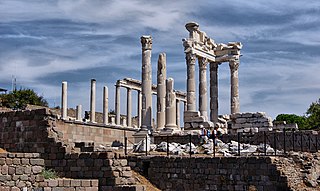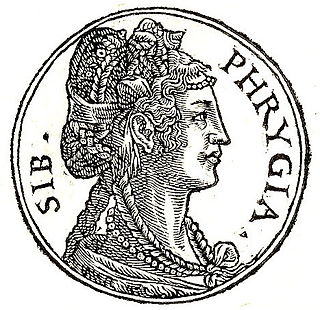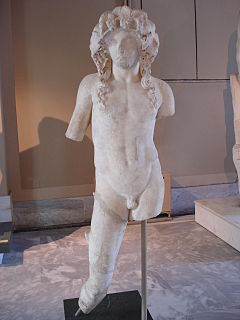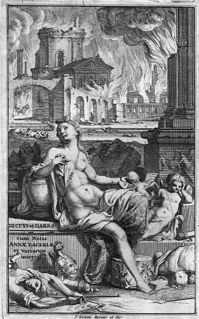
Mysia was a region in the northwest of ancient Asia Minor. It was located on the south coast of the Sea of Marmara. It was bounded by Bithynia on the east, Phrygia on the southeast, Lydia on the south, Aeolis on the southwest, Troad on the west, and the Propontis on the north. In ancient times it was inhabited by the Mysians, Phrygians, Aeolian Greeks and other groups.

In the extended complement of sibyls of the Gothic and Renaissance imagination, the Phrygian Sibyl was the priestess presiding over an Apollonian oracle at Phrygia, a historical kingdom in the west central part of the Anatolian highlands. She was popularly identified with Cassandra, prophetess daughter of Priam's in Homer's Iliad.

The Sakarya is the third longest river in Turkey. It runs through the region known in ancient times as Phrygia. It was considered one of the principal rivers of Asia Minor (Anatolia) in classical antiquity, and is mentioned in the Iliad and in Theogony. Its name appears in different forms as Sagraphos, Sangaris, or Sagaris.
Sebaste was a common placename in classical Antiquity. Sebaste was the Greek equivalent (feminine) of the Latin Augusta. Ancient towns by the name sought to honor Augustus or a later Roman emperor.
Apamea or Apameia is the name of several Hellenistic cities in western Asia, after Apama, the Sogdian wife of Seleucus I Nicator, several of which are also former bishoprics and Catholic titular see.

Tripolis on the Meander – also Neapolis, Apollonia, and Antoniopolis – was an ancient city on the borders of Phrygia, Caria and Lydia, on the northern bank of the upper course of the Maeander, and on the road leading from Sardes by Philadelphia to Laodicea ad Lycum. It was situated 20 km to the northwest of Hierapolis.

Synnada was an ancient town of Phrygia Salutaris in Asia Minor. Its site is now occupied by the modern Turkish town of Şuhut, in Afyonkarahisar Province.

Daretis Phrygii Ilias De bello Troiano is an epic poem in Latin, written around 1183 by the English poet Joseph of Exeter. It tells the story of the ten year Trojan War as it was known in medieval western Europe. The ancient Greek epic on the subject, the Iliad, was inaccessible; instead, the sources available included the fictional "diaries" of Dictys of Crete and Dares of Phrygia. When Joseph's text was printed for the first time in 1541, it was actually erroneously attributed to Dares of Phrygia, announced as the long-lost verse version of his story supposedly put into Latin hexameters by Nepos.
Abbassus or Ambasum, was an ancient town of Phrygia, on the frontiers of the Tolistoboii, in Galatia. It is, perhaps, the same as the Alamassus reported by of Hierocles, and the Amadasse whose bishops attended early church councils. The editors of the Barrington Atlas of the Greek and Roman World note that its probable location is near Synnada, however its precise location is not known.

The Diocese of Asia was a diocese of the later Roman Empire, incorporating the provinces of western Asia Minor and the islands of the eastern Aegean Sea. The diocese was established after the reforms of Diocletian, was subordinate to the Praetorian prefecture of the East, and was abolished during the reforms of Justinian I in 535.
Synaus or Synaos, also spelled Synnaus or Synnaos (Σύνναος), was a city in the Roman province of Phrygia Pacatiana, now Simav, Kütahya Province, Turkey.

In classical antiquity, Phrygia was a kingdom in the west central part of Anatolia, in what is now Asian Turkey, centered on the Sangarios River. After its conquest, it became a region of the great empires of the time.

Adramyttium was an ancient city and bishopric in Aeolis, in modern-day Turkey. It was originally located at the head of the Gulf of Adramyttium, at Ören in the Plain of Thebe, 4 kilometres west of the modern town of Burhaniye, but later moved 13 kilometres northeast to its current location and became known as Edremit.
Traianopolis, Trajanopolis, Tranopolis, or Tranupolis was a Roman and Byzantine city in Phrygia Pacatiana Prima.
Trapezopolis or Trapezoupolis (Τραπεζούπολις) was a city of ancient Caria, and later in the late Roman province of Phrygia Pacatiana Prima.
Augustopolis in Phrygia was a city and bishopric in the Roman province of Phrygia, which remains a Latin Catholic and an Orthodox titular see.
Daldis, was a town on the borders of ancient Lydia and Phrygia, a former bishopric, and is now a Latin Catholic titular see. It also minted coins in antiquity with the legend Δαλδιανων. It also bore the name Flaviocaesaria or Phlabiokaisareia, which is not attested among ancient authors but is reconstructed from epigraphic and other evidence.
Peltae (Peltæ) or Peltai was a city and bishopric of ancient Phrygia in Asia Minor, which remains a Catholic titular see.
Metropolis was an ancient town in the southern part of Phrygia, belonging to the conventus of Apamea. That this town is different from the more northerly town of the name in northern Phrygia, is quite evident, even independently of the fact that Stephanus of Byzantium mentions two towns of the name of Metropolis in Phrygia, and that Hierocles. and the Notitiae speak of a town of this name in two different provinces of Phrygia. In Roman times, it was assigned to the province of Pisidia, where it became a bishopric. No longer a residential see, it remains, under the name Metropolis in Pisidia, a titular see of the Roman Catholic Church.
Stectorium or Stektorion was a town of ancient Phrygia, in the Phrygian Pentapolis between Peltae and Synnada, inhabited during Roman and Byzantine times. Pausanias believed that Mygdon's tomb was located here.








